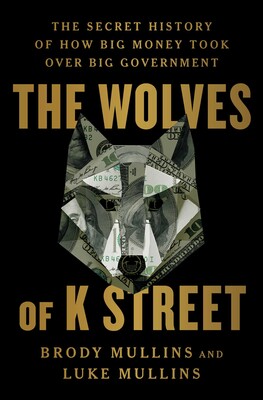The following is an excerpt from Brody Mullins and Luke Mullins’s book,“The Wolves of K Street: The Secret History of How Big Money Took Over Big Government,” now available from Simon and Schuster.
Check out today’s episode of podcast Capitalisn’t featuring Brody Mullins.
The Avastin campaign had been a massive, complex undertaking. Morris and Courtovich had enlisted the help of dozens of lobbyists and consultants. They’d conducted focus groups, created a new organization, made political contributions, manipulated the press, met with lawmakers, and delivered targeted ads over social media—all to create the false impression of a groundswell of public support for an expensive, and ultimately unproven, breast cancer treatment. Yet nearly the entire lobbying effort was carried out in secret. By employing a new approach to political influencing that had been gaining favor over the previous few years, Morris and Courtovich were able to keep their Avastin campaign hidden from reporters, consumers, and the FDA officials they were seeking to sway. The new approach was called shadow lobbying.
This more advanced form of lobbying gained favor in the wake of Washington’s last great lobbying and corruption scandal. The unintended consequences of the post-Abramoff reform effort, as it turned out, extended beyond the DC fund-raising circuit. When the new legislation banned lobbyists from handing out gifts to lawmakers, mandated more disclosures on lobbying activities, and drew additional public scorn to an already reviled profession, K Street did something no one expected. It went underground.
In the first decade under the new rules, more than 3,200 lobbyists—over a fifth of the entire industry—stopped reporting any efforts to influence Congress or the administration. These influence peddlers hadn’t retired from the profession; they’d simply stopped registering as “lobbyists”—a term that carried an undesirable stigma—and started calling themselves “consultants” or “strategists.” They still worked to influence policy but made sure their activities fell outside the strict definition of lobbying. For example, federal law requires anyone who spends more than 20 percent of their time directly influencing a public official to register as a lobbyist. To avoid hitting the critical threshold, influence peddlers began installing time-tracking software on their computers, according to Politico, or asking colleagues to make lobbying calls on their behalf. There was even a cottage industry of lawyers who monitored the time spent by influence peddlers to make sure they devoted less than 20 percent of their hours on lobbying work in order to avoid triggering the law’s threshold for filing lobbying disclosure reports. The post-Abramoff reforms didn’t reduce lobbyists’ clout but simply pushed the industry deeper underground.
The reforms also accelerated the shift in lobbying strategies from traditional insider approaches to the more advanced outside pressure tactics— public relations campaigns, grassroots efforts, new media ploys—intended to shape public opinion among the lawmakers’ constituents back home in their districts. This evolution from inside to outside strategies would have a transformative effect on the business of Washington. Since it takes more resources to reach an entire voter block than it does a single lawmaker, the political-influence industry experienced a period of rapid expansion. Instead of simply buttonholing a member of Congress, lobbying firms were now regularly collaborating with a broad spectrum of industries, including public relations strategists, social media gurus, political consultants, pollsters, and experts in data analytics. And as new businesses sprouted up on K Street, the flow of money and man power directed toward political influence exploded. While the number of registered lobbyists was on the decline, the broader advocacy industry in Washington swelled by nearly 25 percent to 115,000 people from 2002 to 2016, according to a report by the Stephen S. Fuller Institute for Research on the Washington Region’s Economic Future at George Mason University.
For influence peddlers, this approach offered another benefit. While efforts to lobby Congress directly must be reported publicly, there’s no requirement to disclose activities designed to influence their constituents. As such, these indirect lobbying campaigns could be conducted under cover of darkness. The 2007 ethics reforms served only to reinforce this shift in tactics.When the ban on gift giving further limited the ability of lobbyists to influence lawmakers directly, K Street firms directed even more of their resources toward trying to achieve their policy objectives by shaping the opinions of voters. At the height of Evan Morris’s work with Jim Courtovich, Genentech’s advocacy budget had ballooned to $50 million, yet only $5 million was spent on traditional lobbying activities. The remaining $45 million was for public affairs, grassroots, polling, data analytics, and other tactics that fell outside the technical definition of lobbying. And on account of the gaps in the regulation of K Street, none of this $45 million shadow lobbying budget had to be disclosed to the public.
It was here that the modern influence industry was born. To build his firm in the 1970s, Tommy Boggs had used his personal connections to directly persuade lawmakers to back the interests of his corporate clients. In the 1980s Black Manafort brought the tools they’d developed as campaign consultants to the business of lobbying. During the 1990s and 2000s, Tony Podesta was using his experience as a liberal activist to further advance the science of outside influence peddling. Now, in the wake of the post-Abramoff reforms, Morris and Courtovich were blazing a trail in the new world of shadow lobbying, where DC-based operators carry out the secret, sophisticated campaigns that target voters far beyond the Beltway, foment seemingly organic public outcries, and pressure lawmakers into taking actions that benefit their corporate clients. It was this very script that Morris had used for his Tamiflu coup, and that he and Courtovich had followed in their Avastin campaign.
Excerpted from “The Wolves of K Street: The Secret History of How Big Money Took Over Big Government.” Copyright © 2024 by Brody Mullins and Luke Mullins. Reprinted by permission of Simon & Schuster, Inc. All rights reserved.
Articles represent the opinions of their writers, not necessarily those of ProMarket, the University of Chicago, the Booth School of Business, or its faculty.







